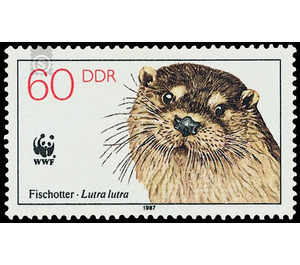Commemorative stamp series - Germany / German Democratic Republic 1987 - 60 Pfennig
Theme: Animals
| Country | Germany / German Democratic Republic |
| Issue Date | 1987 |
| Face Value | 60.00 |
| Color | brown |
| Perforation | K 14 |
| Printing Type | Rotogravure 2 |
| Stamp Type | Postage stamp |
| Item Type | Stamp |
| Chronological Issue Number | 2852 |
| Chronological Chapter | GER-DDR |
| SID | 876089 |
| In 16 Wishlists | |
Endangered Animals - Otter The Ministry of Posts and Telecommunications of the German Democratic Republic publishes four multi-color special postage stamps depicting fish otters. Special cancellations from 7th July to 6th September 1987 Otter Within the family Marder (Mustelidae) belongs the otter, Lutra lutra (Linné 1758), to the subfamily of the Otter, which is distributed worldwide. The 18 species belonging to this systematic category are also known as Aquatic Marshes, a very apt name, because all otter species: otters, giant otters, finger otters, small - billed otter, sea otters - have adapted well to life in the water. The elongated, flat streamlined body with seamless transition into the strong, pointed tail allows rapid movement in the water. The swimming and diving performances are promoted by the presence of webbed webs between the five toes. The nose, eyes and ears are set in the broad face so that they protrude from the water during normal swimming and always provide orientation. The eye angle and special adjustment devices in the eye allow you to see well under water, which is absolutely necessary for hunting. The shiny, silky-soft undercoat coat is waterproof, an important prerequisite for the regulation of body temperature in the wet element. The otter measuring from one meter to the tip of the tail reaches weights between 6 and 10, exceptionally up to 15 kg. The otter inhabits all of Europe, the extreme northwest of Africa and large parts of Asia; only in the zone beyond the Arctic Circle, in the Central Asian deserts, in Japan, in the south of India and on the Southeast Asian islands, the species is missing. The vertical limit is about 2,500 m above sea level. The habitat consists of flowing and stagnant water, streams and rivers, provided they are not too shallow and have adequate nutrition, ponds, lakes, rugged landscapes, floodplains. The more varied the terrain is structured, also vegetationsmäßig, the more likely can be expected with otter deposits. The otter is essentially nocturnal. Where the animals live undisturbed, they can also be seen outside their burrows during the day, like to sunbathe. The underground buildings are mostly dug by themselves. Occasionally, the otter uses abandoned fox, roof, muskrat, or rabbit pens when they are on the shore for a stopover or adjusts them to his needs if he wants to live in them all the time. Access to the construction is usually half a meter under water. From there, the otter climbs up a passage to his living boiler. This is usually above the highest flood mark. Each building also has a headwater outlet, which also serves as a "duct". In the living boiler, two to five young are born after a gestation period of 60 to 70 days. The offspring is initially short-haired and helpless and has a fairly long youth development. The eyes open only at the age of four to five weeks, the nursing period lasts up to four months, the mother's care for up to one year, and the sexual maturity is reached only after two to three years. During the activity time, the otter is swimming a lot and diving. Elegant and fast he moves through the water. Dive times can be six to eight minutes. The prey is not only, as the name suggests fish, but it also captures rodents, birds, especially water fowl, takes their clutches and also consumes amphibians, crabs and insects , In the GDR, as in almost all of Europe, the otter has become very rare for some time, caused by his choice of food (fish!), Which made him a competitor of humans, who mercilessly through profound environmental changes (river straightening, bank fortifications, water pollution, etc.) pursued. According to the 1984 Speech Protection of the GDR, the otter is one of the protected endangered species (category a) and thus enjoys the highest protection status. The current total GDR population is estimated at about 500 individuals. The deposits concentrate on the landscapes in the lowlands from the Lausitz to Mecklenburg.


